The Cornell Lab Bird Academy › Discussion Groups › Nature Journaling and Field Sketching › The Power of Reflection
-
Bird AcademyBird AcademyWhat are your favorite nature writers and what about their work inspires you? Share your experiences with writing reflections in your journal.You must be enrolled in the course to reply to this topic.
-

-
I discovered Kim Heacox after I had the opportunity to do some back country kayak trips in Glacier Bay, Alaska. His memoir, The Only Kayak, shows his heartfelt love of the area and understanding of the natural world and its importance. He felt, as do I, that special places like Glacier Bay are few and far between and the need to preserve them are enormous.
-
My first experience with nature writing was when I started teaching high school English. It seems impossible, but I had never read Henry David Thoreau until I started teaching over 30 years ago. I taught American Lit to a bunch of 11th graders and eventually 10th graders when we shifted the curriculum. Don’t ask how I managed to miss this icon of nature writing during all of my schooling. I couldn’t tell you. But as I read passages from Walden for the first time, I was captivated by his links between the natural world, everyday life, and emotions. I started assigning photo essays to my students and eventually learned about the Walden Woods Thoreau Summer Institute. During that time, we read various books, essays, and poems from Walden to “Walking” to Cape Cod and beyond. I took students to the woods in town, and they observed, took pictures, and wrote. Some loved it; most students saw it as a way to get out of classes for the day, but all understood the importance of maintaining open spaces in their communities. Places where they could go to shake off a bad day, contemplate life, and listen to the world of the woods. I started seeking out more writers. I enjoy reading David Gessner and Mary Oliver’s works and continue exploring various authors. Each writer brings a different part of the country to light. I especially love Mary Oliver’s essay “Owls,” published in Owls and Other Fantasies: “But the great horned I can’t imagine in any such proximity-- if one of those should touch me, it would touch the center of my life, and I must fall. They are the pure wild hunters of our world.” Her words capture the essence of a being so beautiful and powerful. Over the years, I have gone into Hopedale Parklands, sat, listened, and written about my thoughts. It’s forced me to look at everything in nature differently. I see two trees emerging from a common stump and envision people buried upside down, only hips and legs protruding from the earth. I hear the wind move through the trees and know it’s the fall wind pulling at crisp leaves or the winter wind no longer buffered by them. I’m so glad the email for this class popped up unexpectedly in my inbox just as I was thinking about taking a beginner art class. After taking this class, I see light, reflection, and color in ways I hadn’t before. It is another step closer to learning how to capture the essence of what I see and hear. Art is not my forte by any stretch, but I now understand better how to capture some images that I want to ponder more deeply in my writing.
-
I like Thoreau, and Corinne Roosevelt Robinson's "The Path That Leads To Nowhere". I often am hiking with my Westie who usually alerts me to wildlife before I would have noticed. Fortunately, he is quiet and doesn't bother with anything but chipmunks and squirrels. This sketch is a day we were out together. It still needs fine tuning. If I hadn't taken time there, I would not have noticed the shadows on the water. I am curious what species of fish dwell here and if there are turtles and frogs.

-
So may writers inspire me daily, a few of my favorites are John muir and Dara McAnulty, the all express their love of nature through journaling and art.
-
My favorite nature writers are: Kelly Brenner, author of Nature Obscura, because I love her endlessly curious and interested approach to nature; Douglas Tallamy, author of Bringing Nature Home, Nature's Best Hope, and The Nature of Oaks, for inspiring me to want to bring native habitats back into privately owned spaces; and Ed Yong, author of An Immense World, for creating in me a desire to understand the umwelt, or sensory experience, of the wildlife I encounter. I was also inspired by The Yellow Jacket poem above to write a short poem about a Dark-Eyed Junco I encountered on a forest trail.

-

-

-
May 4, 2023. Favorite nature writers - I had trouble with this one, not sure why, because I read a LOT of natural history, or non-fiction with natural leanings. I came up with authors whose writing I have loved, such as Scott Wiedensaul's Living on the Wind (a deep dive into bird migration), Mia Kankimäki's The Women I think about at Night (travel, exploration, writing, thinking, self-reflection). But I don't consider them "nature writers". Mark and Delia Owen's The Cry of the Kalahari is another. What I love about these three (and many others) is the quality of the writing, the storytelling, and how evocative they are of place - which I think perhaps is what I'm trying to explore in my field sketching. If I can feel a place in a way that allows me to produce a watercolor sketch that evokes that feeling, well, then I've arrived! Reflections - When I wander out in the woods, I certainly reflect on my surroundings, but I don't tend to express that in my journal. When I tried to organize these thoughts, it turns out that they lean toward reflections on the people who have made an impact long before I stood in that spot. Stone Walls - Was there a solitary farmer, making the rounds, picking up stones after winter had passed? was it a family outing to pile the stones, step back, have a look, and add one more? Was it to keep the cows out? keep the cows in? The landscape looked much different then than it does now... I'm here for the trail through the trees - those farmers worked hard to remove the trees - clear the land for a hay field, for a pasture. And once felled, what became of those fallen oaks? lumber, fence posts, firewood? a house, a barn? Now the oaks fall and lie there - scaffolding for a squirrel, upturned roots offering underground crannies for a black rat snake, a chipmunk (ah - one or the other, not both). One day I'll try to capture a stone wall in watercolor - there is so much to it :-) When my thoughts turn to birds or plants - I tend to think about early naturalists - not in Connecticut specifically, but those who wandered the forests and clearings well before the farms were everywhere. They were collectors of observations but also of objects (plants, birds). The Baltimore Oriole caught my attention today - the first I've seen this spring. What a great example. Wikipedia says Carolus Linnaeus described and named it in 1758, based on the heraldic colors of Lord Baltimore (golden yellow and black). Well, a deeper dive shows that English settlers in the area that became the US state of Maryland were calling it the Baltimore Bird in 1669, and yes, they named it for one of their colonial governors, indeed of the Baltimore lineage. Now I find Mark Catesby, a young Englishman and one of the first naturalist/artists of the American colonies, who included this bird in his work The Natural History of Carolina, Florida and the Bahama Islands, published in 1731. Catesby called it Icterus, the Baltimore Bird. Carl Linnaeus very likely used Catesby's description in his Systema Naturae (10th edition), but changed the name to Baltimore Oriole because he (old Carl) was familiar with the European orioles that look similar - but Catesby was right! It's an Icterus, of the American family of blackbirds.
 Mark Catesby's Baltimore Bird (above) and my Baltimore Oriole (below, done a few weeks ago, for a friend).
Mark Catesby's Baltimore Bird (above) and my Baltimore Oriole (below, done a few weeks ago, for a friend).
 I'll wrap up my reflections with this - Naturalists, scientists, observers, thinkers, artists, journallers - we have all been at this task for CENTURIES!! Linnaeus may have put his binomial pen to paper in 1758, but I've only scratched the surface, and found that he stood on the shoulders of oh so many others. We now have incredible access to information, but those facts are built from the observations of people like us, through centuries of spending time in nature, with journal and sketchbook in hand.
It has been so wonderful to spend this time with all of you, these last few weeks, and to see your sketches, paintings, observations, words, poetry. Wow, you are all an inspiration. I'm so excited to see what's around the next bend in the trail. - Sue H.
And Liz - thanks for being the spark, so gentle and encouraging, but, as Bruce Springsteen said, you can't start a fire without a spark.
I'll wrap up my reflections with this - Naturalists, scientists, observers, thinkers, artists, journallers - we have all been at this task for CENTURIES!! Linnaeus may have put his binomial pen to paper in 1758, but I've only scratched the surface, and found that he stood on the shoulders of oh so many others. We now have incredible access to information, but those facts are built from the observations of people like us, through centuries of spending time in nature, with journal and sketchbook in hand.
It has been so wonderful to spend this time with all of you, these last few weeks, and to see your sketches, paintings, observations, words, poetry. Wow, you are all an inspiration. I'm so excited to see what's around the next bend in the trail. - Sue H.
And Liz - thanks for being the spark, so gentle and encouraging, but, as Bruce Springsteen said, you can't start a fire without a spark. -
Beautiful job on the Baltimore! I have Bullock's around here. Such striking birds!
-
-
Some of my favorite nature writers have been Edwin Way Teale (his series Journey into Summer, etc.), Barry Lopez, Arctic Dreams, and the poetry of Wendell Berry. Thank you Liz, for this wonderful class.
-
The Patagonia founder Yvon Chouinard recently posted on line, His commitment to the environment. I think that this is important for a class like this to consider. Journaling is inspiring. I am a retired art teacher and can' wait to go out and practice the many valuable lessons I have learned in this course.

-
I have not read many poetries or nature writers' books, though I am an avid reader of other genres. nature journalling is the new passion I developed from my travel diary concept. I used to write my travel journal as information. This nature journaling is an amazing field and was reading loads of information from the internet and found from this course and also watching Mr. John Muir's nature journaling videos were very inspiring. We as a family love bird watching, nature walks, trails, and hiking, I want to really learn and understand the concept of nature journaling in a more professional way to refine my drawings and understand the detailing of journaling.
-
Thinking about this, I realize that I haven't read a lot of the classics of nature writing (including most of the works that are quoted above). I consider "nature writing" to be a fairly broad subject ranging from pure science to memoir. I love anything that inspires me to get outside, especially if it teaches me to notice something new--this includes field guides and trail guides! Some favorites of mine include: Mary Oliver, Rumi, John Muir, Kathleen Jamie, Claire Walker Leslie, In Praise of Paths - Torbjorn Ekelund, The Way Through the Woods: On Mushrooms and Mourning - Litt Woon Long.
-
I enjoyed Charles Darwin's one.
-
One of my favorite book is The Country Diary of an Edwardian Lady or the facsimile reproduction of a naturalist's diary for the year 1906. Edith Holden recored in words and paintings the flora and fauna of the British countryside through the changing seasons of the year. Her diary inspired the outlined lettering I created for the title of this journal page and the the addition of a poem titled Yellow Warbler by Katherine Lee Bates next to my Yellow Warbler painting/drawing.

-
The Country Diary of an Edwardian Lady is a beautiful book! I see Amazon has a coloring book which might be fun.
-
-
I thought about Beatrix Potter as I was starting this journaling class. I have always admired her watercolor paintings and the stories about Peter Rabbit and all the other wonderful animals. Although she is best known for her children’s books, she also did scientific illustrations. Her imagination, creativity and detailed paintings are an inspiration to me.
-
".... pss, wake up! yes, I know, it´s raining and it´s a cloudy day, but, don't you think it's the perfect day to start it drawing? so quiet, relaxing, inspiring... first of all, let me tell you that I can appreciate that you grow and develop in a very healthy way, your warm and incipient brown tones prove it, seems like you feel confortable and calm too, surrounded and protected by all those powerful `acículas´, but... I can see some kind of loneliness, maybe, not too many birds or other species today..." "... yes! you're right, obviously they prefer leafy trees with bushy leaves, making them feel warmer, I suppose offering them more shelter, but I'm not worried, in other conditions they will return, it´s nature and their mechanisms... but let me start sketching you, because in my perception I could appreciate an harmonious and lovely contrast between the different scales of rose on the leaden gray background. creating an anticipatory, balanced and beautiful canvas..." "... hey! and what about me? no connection? no merit? It could be fun, why don´t you try to give shape and relief ... to those brilliant droplets that I keep carefully in balance and their double function, drop by drop, slowly, with a lot of pulse and the exact amount of water and paint with your amazing and fantastic brushes? can you do it achieving the same effect?..."


-
I quite enjoyed Charles Darwin's passage about bioluminescence in the sea. His writing drew me in and I was able to imagine what he was describing with much enjoyment.
-
"...good morning, good morning, good morning. Watch, now, how I start the day, in happiness, in kindness." (From Why I Wake Early by Mary Oliver).

-
I loved the other students' reading suggestions. Annie Dillard's Pilgrim at Tinker Creek captures my imagination and Lilia's Trotter's simple but exquisite water colors take my breath away. Elizabeth Goudge, a twentieth century British fiction writer first sparked my interest in her descriptions of nature. She captures not just the details but the essence of a thing, often with humor. I sense God speaking to me through creatures and beauty. Below is one such lesson.
 “Chip. Chip. Teacher, teacher.”I scan branches, searching for the bird with its unmistakeable calls. Ah, there he is, so easy to spot with bright red plumage. Cardinals make me feel satisfied, because they’re the one bird I can always identify.
I call him, Mr. Cardinal, because he reminds me of a creature suitable for Downton Abbey. His crest gives him an air of importance like a top hat. The black mask he wears contrasts pleasingly with the red, and he wears it like a British gentleman lost from a masquerade party looking for his wife.
Mrs. Cardinal, likewise, fills her sophisticated, if old-fashioned, role. She fusses over the nest, responsible for its construction and tidiness. Her garb of elegant feathers blend hints of orange, rust, gray and sand. She’s not nearly as showy as her counterpart, but doesn’t need to be, which makes me respect her all the more. She tends the eggs while her husband flies away to hunt, and returns to wait upon her with his catches. In the birdbath, the pair take turns watching for predators and bathing. These two birds live respectable, monogamous lives. Each has an important job and relies on the other to do their part. They delight me and grant me a feeling of wholeness.
That is, except for one of Mr. Cardinal’s curious behaviors. He habitually taps his reflection. He pecks the window, and I caught him striking a car’s side mirror. At first, his action is humorous, but when repeated, it becomes irritating and alarming. The poor fellow will damage himself and drive us crazy in the process of exorcizing his doppelgänger. Of course, he’s defending his territory and his spouse.
I wonder what Mr. Cardinal sees? A frightening masked threat? A disgusting flirt? What in his reflection alarms or repulses him that he must attack?
Mr. Cardinal, please stop. I am grieved that you peck at something you wrongly perceive. You are an entirely satisfactory bird just as you are, but you’re wasting your efforts in this never-ending loop while your family needs you elsewhere. The only way you’re going to be rid of your reflection is to turn and fly away.
“Chip. Chip. Teacher, teacher.”I scan branches, searching for the bird with its unmistakeable calls. Ah, there he is, so easy to spot with bright red plumage. Cardinals make me feel satisfied, because they’re the one bird I can always identify.
I call him, Mr. Cardinal, because he reminds me of a creature suitable for Downton Abbey. His crest gives him an air of importance like a top hat. The black mask he wears contrasts pleasingly with the red, and he wears it like a British gentleman lost from a masquerade party looking for his wife.
Mrs. Cardinal, likewise, fills her sophisticated, if old-fashioned, role. She fusses over the nest, responsible for its construction and tidiness. Her garb of elegant feathers blend hints of orange, rust, gray and sand. She’s not nearly as showy as her counterpart, but doesn’t need to be, which makes me respect her all the more. She tends the eggs while her husband flies away to hunt, and returns to wait upon her with his catches. In the birdbath, the pair take turns watching for predators and bathing. These two birds live respectable, monogamous lives. Each has an important job and relies on the other to do their part. They delight me and grant me a feeling of wholeness.
That is, except for one of Mr. Cardinal’s curious behaviors. He habitually taps his reflection. He pecks the window, and I caught him striking a car’s side mirror. At first, his action is humorous, but when repeated, it becomes irritating and alarming. The poor fellow will damage himself and drive us crazy in the process of exorcizing his doppelgänger. Of course, he’s defending his territory and his spouse.
I wonder what Mr. Cardinal sees? A frightening masked threat? A disgusting flirt? What in his reflection alarms or repulses him that he must attack?
Mr. Cardinal, please stop. I am grieved that you peck at something you wrongly perceive. You are an entirely satisfactory bird just as you are, but you’re wasting your efforts in this never-ending loop while your family needs you elsewhere. The only way you’re going to be rid of your reflection is to turn and fly away. -
I appreciate the writing of Rachel Carson with her Sense of Wonder with the "dreamy quality of remembered joy". With a nature journal that I kept of my journey through the Pilbara area of Western Australia, I can remember my thoughts and impressions on that wonderful journey with its striking red rocks, green spinifex, and Sturts Desert Pea. Back then, I was mostly a photographer but I also carried a nature journal and colored pencils. Since I was traveling with others and could only take pictures when the group stopped, I wrote and sketched what I saw to compliment my photography. I will never forget that journey and it would play a role in my life as a science educator some years later.

-
I love all the nature writers already mentioned, but want to add an Appalachian woman writer Barbara Kingsolver. Even though she is a fiction writer, her background in biology gives such depth and quality to her descriptions about nature. Also, she has written some essays, memoir, and poetry.
-
I like to read about people who have outdoor adventures, past and present. Two of my favorites are Labyrinth of Ice and Swimming to Antarctica.
-
I don't have a single favorite author, but one of my go-to books is Home, by Beth Powning. Her writing and photography resonate with me. Here a few quotes: "I'm five years old and I know the sacredness of bluets, and the primacy of trees, the world that came first." "Spring wildflowers cannot be picked; they're as ephemeral as the season itself. I've arrived home with limp trout lilies int he palm of my hand. They cannot bear separation from the soil." So I picked a couple of sitspots, down in my horses' pasture where I sketched and painted the pasture hues of spring: white flowers, blue flowers, and yellow flowers. I practiced with my watercolors, handling the amount of water in the brush, mixing colors, and observing the tiny details. I experimented with watercolor pencils, and the Sakura pen which we didn't cover in the class, unfortunately.
 I
I

Read More:
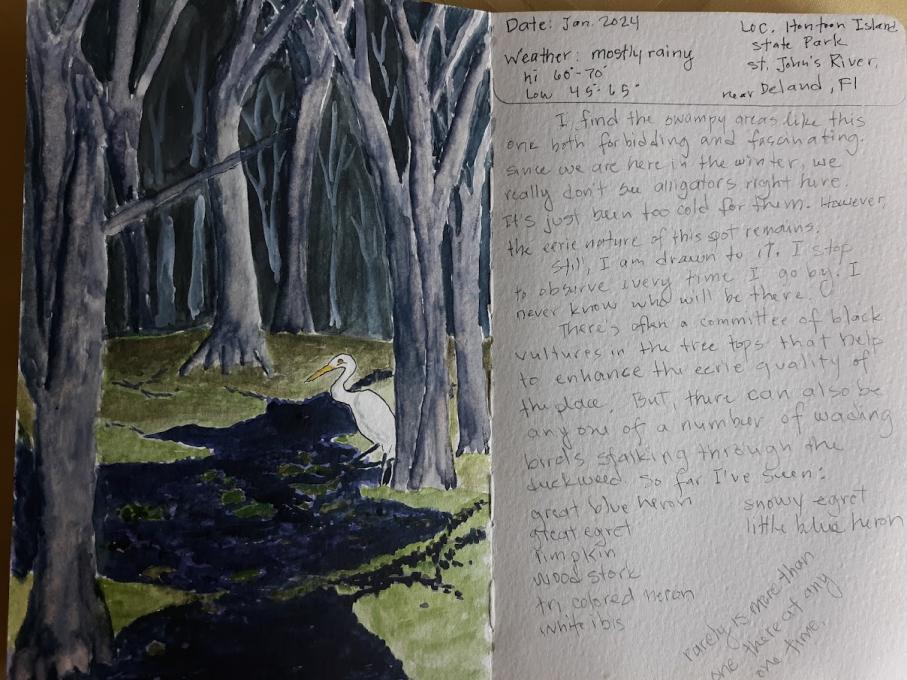
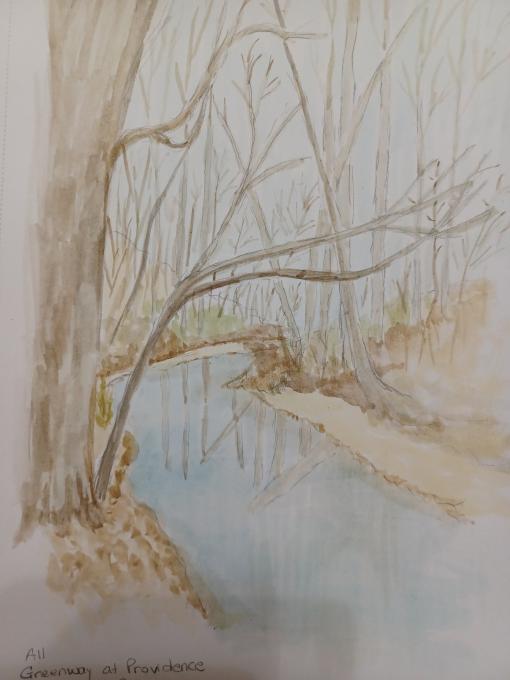
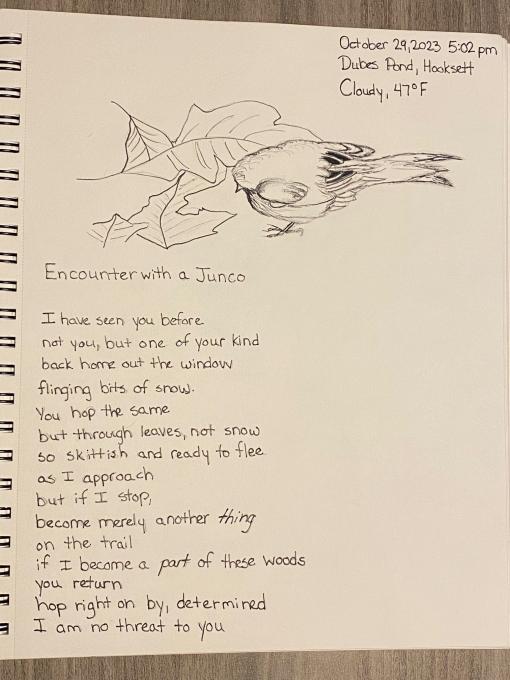
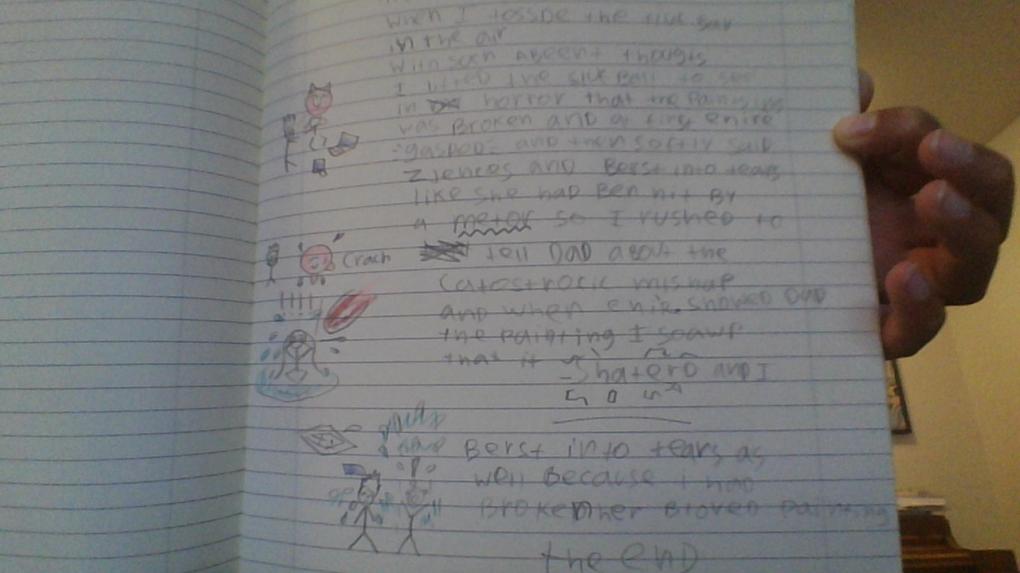
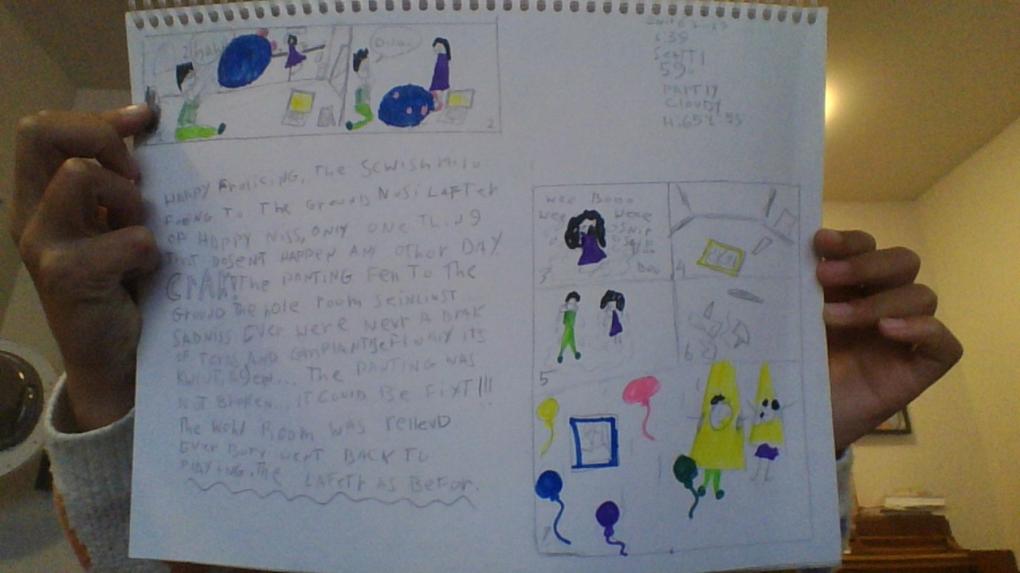
 Mark Catesby's Baltimore Bird (above) and my Baltimore Oriole (below, done a few weeks ago, for a friend).
Mark Catesby's Baltimore Bird (above) and my Baltimore Oriole (below, done a few weeks ago, for a friend).
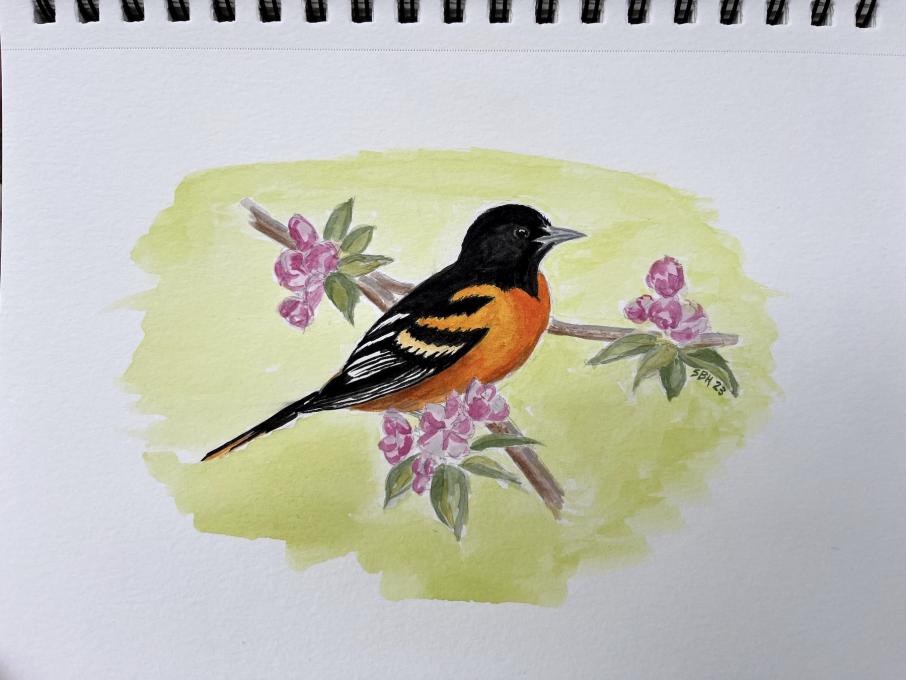 I'll wrap up my reflections with this - Naturalists, scientists, observers, thinkers, artists, journallers - we have all been at this task for CENTURIES!! Linnaeus may have put his binomial pen to paper in 1758, but I've only scratched the surface, and found that he stood on the shoulders of oh so many others. We now have incredible access to information, but those facts are built from the observations of people like us, through centuries of spending time in nature, with journal and sketchbook in hand.
It has been so wonderful to spend this time with all of you, these last few weeks, and to see your sketches, paintings, observations, words, poetry. Wow, you are all an inspiration. I'm so excited to see what's around the next bend in the trail. - Sue H.
And Liz - thanks for being the spark, so gentle and encouraging, but, as Bruce Springsteen said, you can't start a fire without a spark.
I'll wrap up my reflections with this - Naturalists, scientists, observers, thinkers, artists, journallers - we have all been at this task for CENTURIES!! Linnaeus may have put his binomial pen to paper in 1758, but I've only scratched the surface, and found that he stood on the shoulders of oh so many others. We now have incredible access to information, but those facts are built from the observations of people like us, through centuries of spending time in nature, with journal and sketchbook in hand.
It has been so wonderful to spend this time with all of you, these last few weeks, and to see your sketches, paintings, observations, words, poetry. Wow, you are all an inspiration. I'm so excited to see what's around the next bend in the trail. - Sue H.
And Liz - thanks for being the spark, so gentle and encouraging, but, as Bruce Springsteen said, you can't start a fire without a spark. 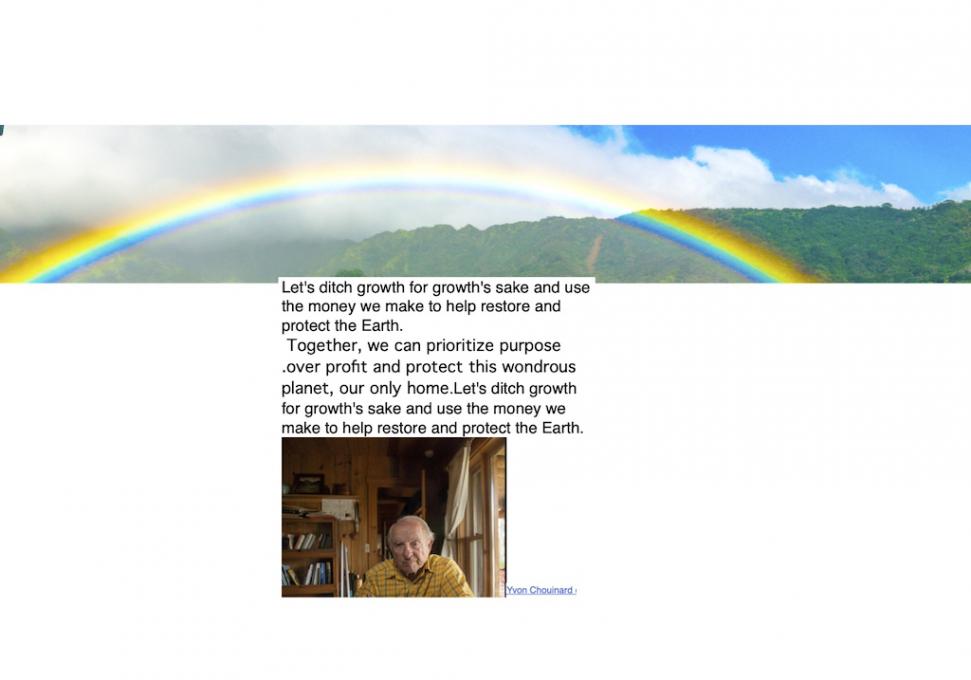
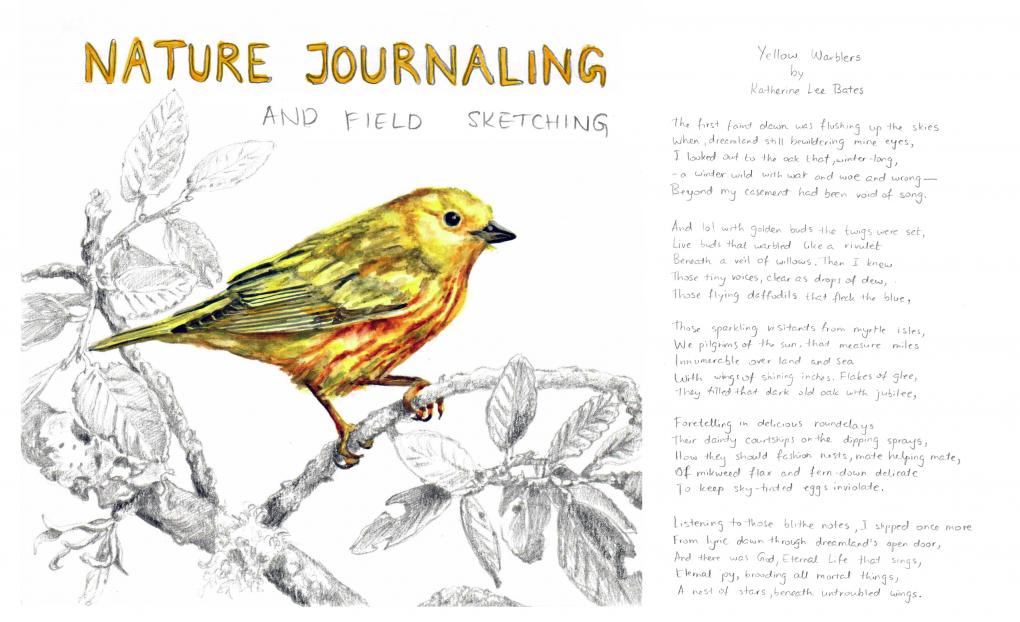

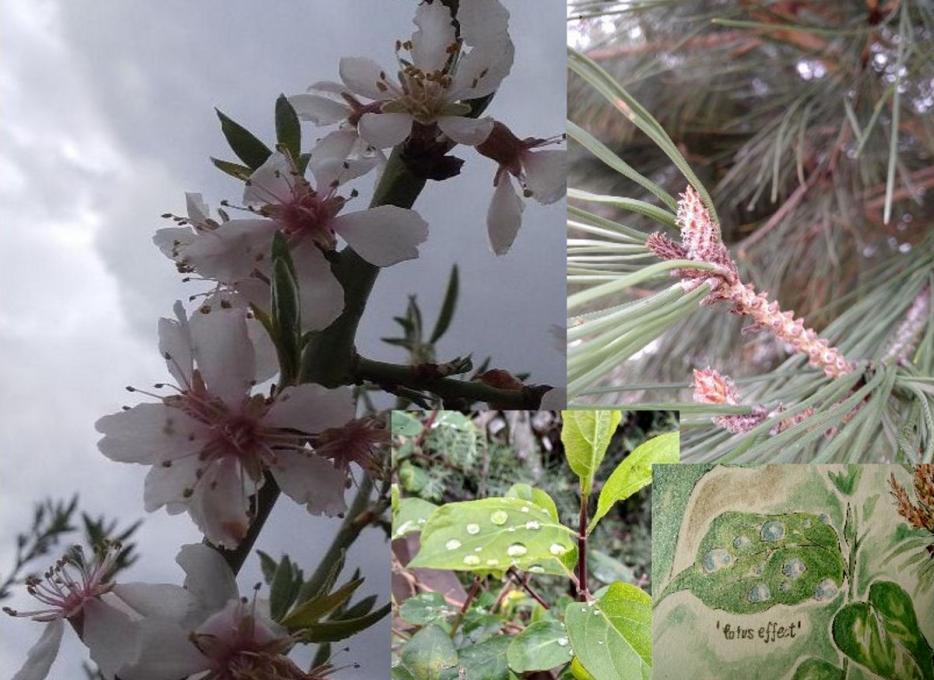
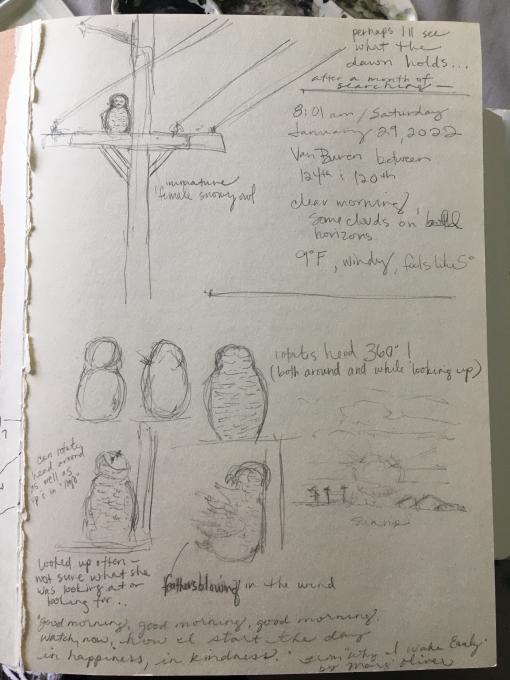
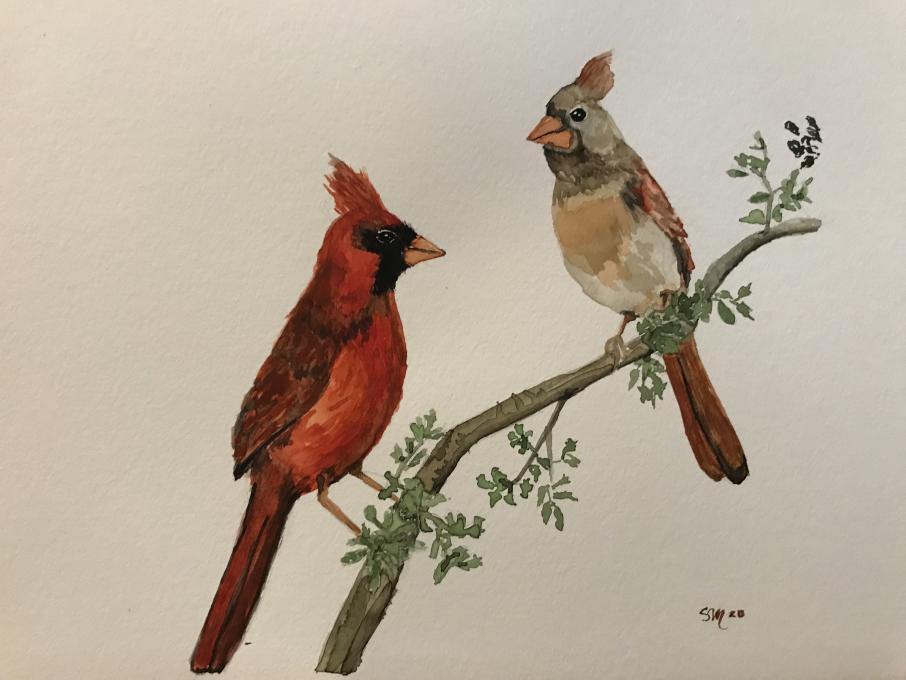 “Chip. Chip. Teacher, teacher.”I scan branches, searching for the bird with its unmistakeable calls. Ah, there he is, so easy to spot with bright red plumage. Cardinals make me feel satisfied, because they’re the one bird I can always identify.
I call him, Mr. Cardinal, because he reminds me of a creature suitable for Downton Abbey. His crest gives him an air of importance like a top hat. The black mask he wears contrasts pleasingly with the red, and he wears it like a British gentleman lost from a masquerade party looking for his wife.
Mrs. Cardinal, likewise, fills her sophisticated, if old-fashioned, role. She fusses over the nest, responsible for its construction and tidiness. Her garb of elegant feathers blend hints of orange, rust, gray and sand. She’s not nearly as showy as her counterpart, but doesn’t need to be, which makes me respect her all the more. She tends the eggs while her husband flies away to hunt, and returns to wait upon her with his catches. In the birdbath, the pair take turns watching for predators and bathing. These two birds live respectable, monogamous lives. Each has an important job and relies on the other to do their part. They delight me and grant me a feeling of wholeness.
That is, except for one of Mr. Cardinal’s curious behaviors. He habitually taps his reflection. He pecks the window, and I caught him striking a car’s side mirror. At first, his action is humorous, but when repeated, it becomes irritating and alarming. The poor fellow will damage himself and drive us crazy in the process of exorcizing his doppelgänger. Of course, he’s defending his territory and his spouse.
I wonder what Mr. Cardinal sees? A frightening masked threat? A disgusting flirt? What in his reflection alarms or repulses him that he must attack?
Mr. Cardinal, please stop. I am grieved that you peck at something you wrongly perceive. You are an entirely satisfactory bird just as you are, but you’re wasting your efforts in this never-ending loop while your family needs you elsewhere. The only way you’re going to be rid of your reflection is to turn and fly away.
“Chip. Chip. Teacher, teacher.”I scan branches, searching for the bird with its unmistakeable calls. Ah, there he is, so easy to spot with bright red plumage. Cardinals make me feel satisfied, because they’re the one bird I can always identify.
I call him, Mr. Cardinal, because he reminds me of a creature suitable for Downton Abbey. His crest gives him an air of importance like a top hat. The black mask he wears contrasts pleasingly with the red, and he wears it like a British gentleman lost from a masquerade party looking for his wife.
Mrs. Cardinal, likewise, fills her sophisticated, if old-fashioned, role. She fusses over the nest, responsible for its construction and tidiness. Her garb of elegant feathers blend hints of orange, rust, gray and sand. She’s not nearly as showy as her counterpart, but doesn’t need to be, which makes me respect her all the more. She tends the eggs while her husband flies away to hunt, and returns to wait upon her with his catches. In the birdbath, the pair take turns watching for predators and bathing. These two birds live respectable, monogamous lives. Each has an important job and relies on the other to do their part. They delight me and grant me a feeling of wholeness.
That is, except for one of Mr. Cardinal’s curious behaviors. He habitually taps his reflection. He pecks the window, and I caught him striking a car’s side mirror. At first, his action is humorous, but when repeated, it becomes irritating and alarming. The poor fellow will damage himself and drive us crazy in the process of exorcizing his doppelgänger. Of course, he’s defending his territory and his spouse.
I wonder what Mr. Cardinal sees? A frightening masked threat? A disgusting flirt? What in his reflection alarms or repulses him that he must attack?
Mr. Cardinal, please stop. I am grieved that you peck at something you wrongly perceive. You are an entirely satisfactory bird just as you are, but you’re wasting your efforts in this never-ending loop while your family needs you elsewhere. The only way you’re going to be rid of your reflection is to turn and fly away. 
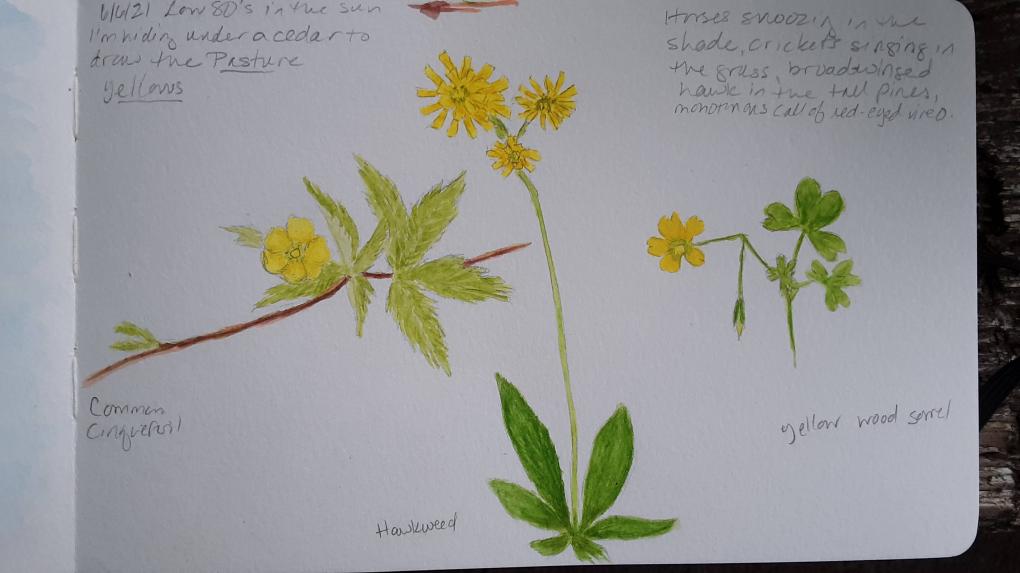 I
I
